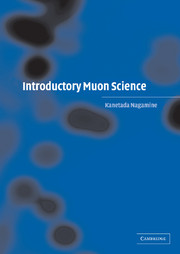Book contents
- Frontmatter
- Contents
- Preface
- List of abbreviations
- 1 What are muons? What is muon science?
- 2 Muon sources
- 3 Muons inside condensed matter
- 4 The muonic atom and its formation in matter
- 5 Muon catalyzed fusion
- 6 Muon spin rotation/relaxation/resonance: basic principles
- 7 Muon spin rotation/relaxation/resonance: probing microscopic magnetic properties
- 8 Muon spin rotation/relaxation/resonance: probing induced microscopic systems in condensed matter
- 9 Cosmic-ray muon probe for internal structure of geophysical-scale materials
- 10 Future trends in muon science
- Further reading
- Index
Preface
Published online by Cambridge University Press: 22 October 2009
- Frontmatter
- Contents
- Preface
- List of abbreviations
- 1 What are muons? What is muon science?
- 2 Muon sources
- 3 Muons inside condensed matter
- 4 The muonic atom and its formation in matter
- 5 Muon catalyzed fusion
- 6 Muon spin rotation/relaxation/resonance: basic principles
- 7 Muon spin rotation/relaxation/resonance: probing microscopic magnetic properties
- 8 Muon spin rotation/relaxation/resonance: probing induced microscopic systems in condensed matter
- 9 Cosmic-ray muon probe for internal structure of geophysical-scale materials
- 10 Future trends in muon science
- Further reading
- Index
Summary
Since the discovery of cosmic rays in 1940, elementary particle muons have become fascinating and exotic particles which can be objectives and/or tools for fundamental physics and applied science. In particular, after intense muons became available by using particle accelerators in 1960, the field of scientific research using muons has been growing year by year.
From the author's viewpoint, three major unique features of muons have formed the basis of all muon-related scientific research: (1) unique mass, such as heavy electrons and light protons; (2) radioactivity with polarization phenomena; and (3) the electromagnetic interaction nature with matter without a strong interaction. These features have promoted the application of muons to: (1) muon catalyzed fusion for future atomic energy; (2) sensitive probes of the microscopic magnetic properties of new materials and biomolecules; and (3) radiography of a large-scale substance for preventing natural disasters, respectively.
The author made special efforts for this book to include a self-contained description of all physics principles required for muon applications. In these applications, we note that muons may be the key particles to provide answers to the basic problems associated with possible crises in human life in the twenty-first century, namely, a shortage of energy resources, the need for more information on the biological functioning of the human body, and the need to prevent natural disasters, such as volcanic eruptions and earthquakes. Complete descriptions are given of ways to apply elementary particle muons to these three major human problems.
- Type
- Chapter
- Information
- Introductory Muon Science , pp. xi - xiiPublisher: Cambridge University PressPrint publication year: 2003



